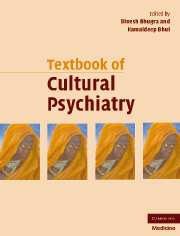Book contents
- Frontmatter
- Contents
- Contributors
- Foreword
- Preface
- Part I Theoretical background
- Part II Culture and mental health
- Part III Culture and mental disorders
- 15 Neurosis
- 16 Schizophrenia and related psychoses
- 17 Affective disorders
- 18 Substance misuse
- 19 Culture and mental disorders: suicidal behaviour
- 20 Personality disorders and culture
- 21 Culture and obsessive-compulsive disorder
- 22 Culture and eating disorders
- 23 Childhood and adolescent psychiatric disorders
- 24 Culture and schizophrenia
- 25 Disorders of ageing across cultures
- Part IV Theoretical aspects of management
- Part V Management with special groups
- Part VI Cultural research and training
- Cultural psychiatry: the past and the future
- Index
- References
21 - Culture and obsessive-compulsive disorder
from Part III - Culture and mental disorders
Published online by Cambridge University Press: 11 August 2009
- Frontmatter
- Contents
- Contributors
- Foreword
- Preface
- Part I Theoretical background
- Part II Culture and mental health
- Part III Culture and mental disorders
- 15 Neurosis
- 16 Schizophrenia and related psychoses
- 17 Affective disorders
- 18 Substance misuse
- 19 Culture and mental disorders: suicidal behaviour
- 20 Personality disorders and culture
- 21 Culture and obsessive-compulsive disorder
- 22 Culture and eating disorders
- 23 Childhood and adolescent psychiatric disorders
- 24 Culture and schizophrenia
- 25 Disorders of ageing across cultures
- Part IV Theoretical aspects of management
- Part V Management with special groups
- Part VI Cultural research and training
- Cultural psychiatry: the past and the future
- Index
- References
Summary
EDITORS' INTRODUCTION
Obsessive-compulsive disorder is one of those disorders in which the contents of the obsessional ruminations and compulsive rituals are very strongly influenced by culture, even though epidemiological data are not as strong as in many other psychiatric disorders. The management of the ritual and ruminations, especially if they are influenced by culture, has to be culturally modified too. One must bear in mind that the genetic aspects of aetiology and management using pharmacotherapy create problems of their own. The role of culture in encouraging purity in the context of food preparation is well described in anthropological and sociological literature.
In this chapter, de Silva and Bhugra highlight the impact of religion and superstition on the aetiology of obsessive compulsive disorders. They argue that, within each culture, there are concerns which are common, which also allow the contents of ruminations to be affected. In addition, the contents also reflect religious ideas and themes. In some religious settings, hyperscrupulosity is noted, which is also heightened in patients with obsessive-compulsive disorder. Themes of dirt, purity, contamination and aggression can be culturally sanctioned. The cognitions vary across cultures, therefore it makes sense that cognitions related to rituals and compulsions will also vary. Personal responsibility as a key component has been shown in some cultures. Similarly, superstition and perfectionism and responsibility have been linked together. It is possible that culturally sanctioned rituals may be seen as aberrant and abnormal if the individual is being assessed outside the context of their culture. Their normal distress thus becomes abnormal and clinicians have a duty to ascertain whether these contents are part of the cultural make-up or are demonstrating real hardship and impairment of functioning.
- Type
- Chapter
- Information
- Textbook of Cultural Psychiatry , pp. 282 - 291Publisher: Cambridge University PressPrint publication year: 2007
References
- 5
- Cited by



